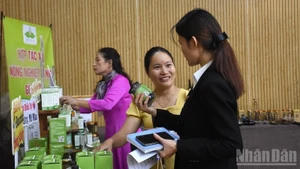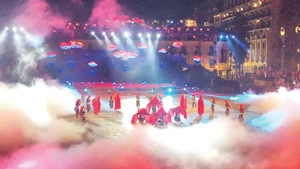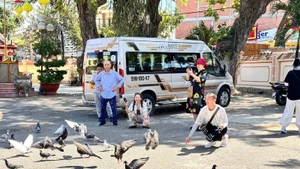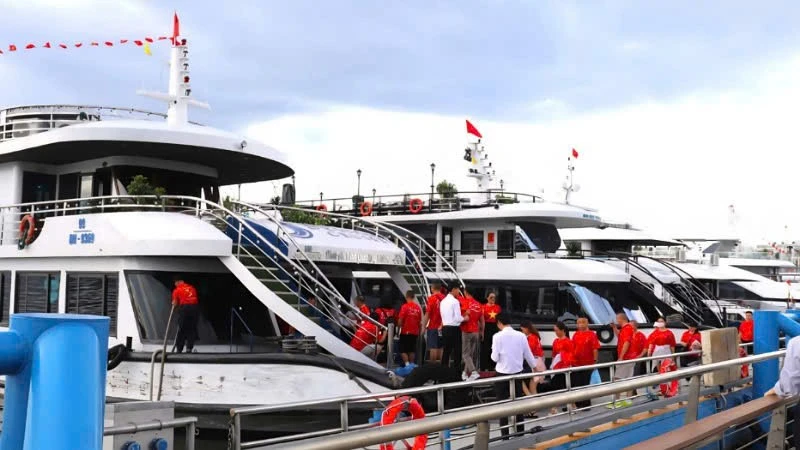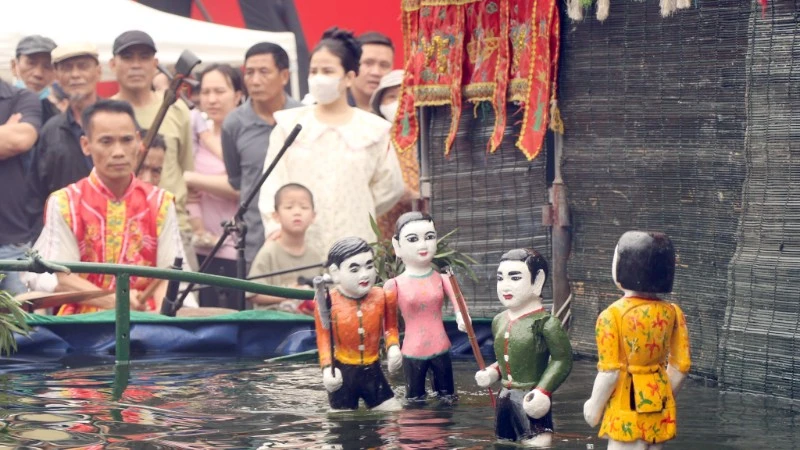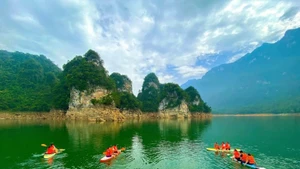These areas are not only a “gold mine” of international value in archaeology, geology and geomorphology, but also spaces that preserve distinctive features of local history and culture, opening up major potential for sustainable tourism development associated with nature conservation and traditional identity.
From geological resources to attractive destination
UNESCO-recognised global geoparks in Viet Nam include: Dong Van Karst Plateau Geopark (recognised in 2010), Non nuoc Cao Bang Geopark (2018), Dak Nong Geopark (2020) and Lang Son Geopark (2024).
Each geopark is regarded as a “living geological museum”, reflecting a harmonious and close connection between the diversity and grandeur of nature and the richness and uniqueness of ethnic cultural colours
The Dong Van Karst Plateau attracts visitors with its magnificent limestone karst terrain associated with the customs, architecture and traditional crafts of H’Mong, Dao, Lo Lo, and Tay communities. Non nuoc Cao Bang impresses with its limestone mountain system interwoven with rivers and streams, Ban Gioc Waterfall and numerous archaeological sites, bearing deep imprints of the culture of the Tay, Nung and H’Mong ethnic groups.
Dak Nong Geopark stands out for its basalt volcanic cave system and the space of gong culture, an intangible cultural heritage of the M’Nong and E De peoples. Lang Son Geopark is known for its ancient rock sediments, breathtaking cave systems and characteristic cultural life of the Tay, Nung and Dao communities
In recent years, based on the distinctive values of global geoparks, various tourism products have taken shape, gradually turning geoparks into competitive advantages for local tourism.
In recent years, based on the distinctive values of global geoparks, various tourism products have taken shape, gradually turning geoparks into competitive advantages for local tourism. In particular, the Dong Van Karst Plateau must be mentioned. Here, many natural and cultural resource sites have become “magnets” for visitors, such as the Tua San alley heritage complex, Nho Que River, Ma Pi Leng Pass, Lung Cu Flag Tower, the Vuong Family Mansion, and community villages such as Lung Cam and Lo Lo Chai. The Management Board of the Karst Plateau has developed four experience routes with 59 typical resource sites.
At the Non nuoc Cao Bang Global Geopark, four tourism experience routes linked to 57 attractions have also been implemented. Popular destinations include Ban Gioc Waterfall, Nguom Ngao Cave, Phia Oac–Phia Den National Park, Pac Bo Relic Site, and the villages of Khuoi Ky and Hoai Khao.
For the UNESCO Dak Nong Global Geopark, the Management Board has developed three tourism routes connecting 41 resource sites, notably Ta Dung Lake, Dray Sap Waterfall, Dak Mil Prison, the N’Trang Guh Memorial Historic Site, and the villages of Buor and Nui.
Four tourism routes associated with 38 sites of the UNESCO Lang Son Global Geopark are also being developed.
Creating appeal from distinctive tourism products
In reality, tourism development in global geoparks still shows a large gap compared with their potential. The level of tourism exploitation across the four geoparks varies significantly in terms of effectiveness and sustainability.
Dr Nguyen Xuan Hai from Faculty of Tourism and Foreign Languages, Viet Nam National University of Agriculture assessed that the biggest “bottleneck” lies in the poor and low-quality tourism product system. More alarmingly, many distinctive and unique resource values have not been properly utilised, notably in the case of the Dak Nong Global Geopark. Almost all volcanic cave resources (nearly 50 caves) here have not yet been invested in or developed.
It is essential to develop distinctive tourism products at global geoparks through specialised diversification, which can be divided into three levels: high-end (geological exploration tours for experts and students), mid-range (adventure and wellness tourism such as mountain climbing and kayaking combined with geological learning), and basic (cultural tourism, visits to historical sites, and local culinary and festival experiences).
Dr Nguyen Xuan Hai (Faculty of Tourism and Foreign Languages, Viet Nam National University of Agriculture)
Dr Nguyen Xuan Hai emphasised that it is essential to develop distinctive tourism products at global geoparks through specialised diversification, which can be divided into three levels: high-end (geological exploration tours for experts and students), mid-range (adventure and wellness tourism such as mountain climbing and kayaking combined with geological learning), and basic (cultural tourism, visits to historical sites, and local culinary and festival experiences).
Cao Quoc Chung, Deputy Director of the Ha Noi branch of A Dong Vidotour Tourism and Trading Company Limited, affirmed that tourism products at global geoparks need to be tangible so that visitors can see, touch and feel them. Scientific values in geology, geography and history must be closely connected with the scenic beauty of nature and local cultural elements, creating “stories” for each destination.
He also noted that the three global geoparks of Dong Van, Cao Bang and Lang Son together form a northeastern tourism route, but product diversification is necessary to avoid overlap and direct competition.





